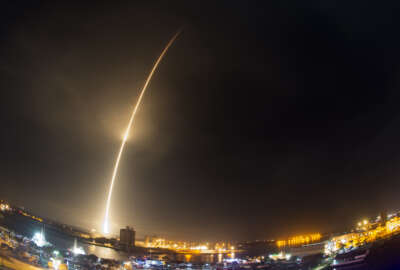
Air Force reorganizes its space forces in preparation for ‘thinking adversaries’
The Air Force is in the midst of a significant reorganization of its space workforce that’s somewhat reminiscent of what began with the IT workforce a decade ago.
The Air Force is in the midst of a significant reorganization of its space workforce that’s somewhat reminiscent of what began with the IT workforce a decade ago. Back then, it became clear to DoD officials that those folks were running something that looked much more like a warfighting platform than an ancillary service that helps out with traditional combat missions.
Under a new construct termed the Space Mission Force, Air Force Space Command is overhauling the training and duty rotations of most of its uniformed workforce to reflect the fact that potential enemies might want to knock out the satellites that just about every modern-day military mission depends on.
“We’ve already seen some countries perform live testing of anti-satellite weapons against their own spacecraft, and if they have the ability to destroy their satellites, they can destroy ours too,” Col. Dean Sniegowski, the total force lead for the Space Mission Force, said in an interview. “We’re going to revamp our crews to respond to threats in a dynamic environment and better support our combatant commanders.”
A white paper Gen. John Hyten, the commander of Air Force Space Command, published last month said the main objective of the SMF is to get the service’s existing space personnel ready to respond against a “thinking adversary” so that the satellite capabilities all of DoD’s commanders have come to take for granted in every military operation for the past several decades aren’t jeopardized in the next one. Without elaborating, it also calls for the new Space Mission Force to be able to “deny” a potential enemy’s space capabilities if the need arises.
Air Force officials weren’t able to provide an estimate of the total number of personnel that would make up the Space Mission Force, but they said current plans don’t call for any net reduction or addition from the workforce that’s already in charge of launching and maintaining satellites and other space assets.
How secure is your network? Share your opinions in a Federal News Radio survey.
The “transformation,” as officials term it, has already taken place within the 50th space wing based at Schriever Air Force Base in Colorado, and the nearby 21st and 460th space wings will follow suit later this year.
The space launch wings at Vandenberg Air Force Base, California. and Patrick Air Force Base, Florida. will also be folded in, along with several National Guard and Reserve units.
“The space crews we have are top-notch — they’re better educated and more talented than any generation we’ve had before,” Sniegowski said. “They can operate and fix our systems, but they’re a little bit lacking in the different things a bad guy can do. We’re trying to get them to the point where if they see a fault or an anomaly, that might actually be an enemy action, and they’re going to have to find a way to work around that threat.”
Aside from adding the concept of enemy action to its existing curriculum, Space Command is reorienting its airmen’s training and duty cycles so that they more closely resemble what a combatant commander might expect to see when he or she asks about the readiness of a combat unit.
Those cycles will vary based on each unit’s specific mission, but Air Force Space Command is treating the 50th Wing as the template, Sniegowski said.
“They’re doing a four-month rotation where they’re essentially doing the day-to-day mission on what’s called the Space Mission Task Force. The point is to try to separate all the extraneous activities we levy on our people, like administrative work, and we also encourage them not to take leave or pursue professional military education,” he said. “Then, they come into a dwell cycle and we can focus on advanced training and bring them into exercises like Red Flag, where they can start looking at what the bad guys are doing to disrupt the mission and how to think outside the box.”
Read more of the DoD Reporter’s Notebook.
Copyright © 2024 Federal News Network. All rights reserved. This website is not intended for users located within the European Economic Area.
Jared Serbu is deputy editor of Federal News Network and reports on the Defense Department’s contracting, legislative, workforce and IT issues.
Follow @jserbuWFED




